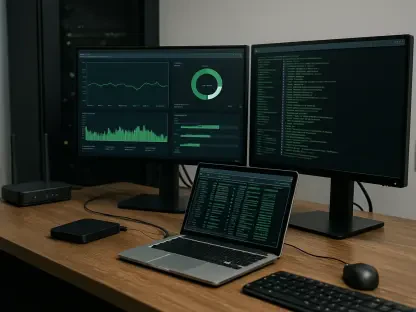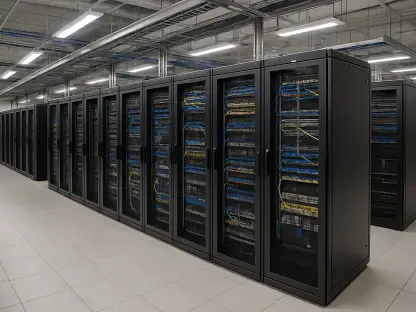In an era where cyber threats are becoming increasingly sophisticated, the global market for Next-Generation Firewalls (NGFWs) is experiencing unprecedented growth, driven by the urgent need for advanced security solutions. Projections indicate that this market, already a critical component of enterprise cybersecurity, is set to expand significantly from its current valuation to an impressive $8.6 billion by 2028, reflecting a robust Compound Annual Growth Rate (CAGR) of 11.4% over the coming years. This surge underscores the escalating demand for technologies capable of countering complex attacks amid the proliferation of connected devices and remote work environments. As businesses grapple with vulnerabilities introduced by Internet of Things (IoT) trends and Bring Your Own Device (BYOD) policies, NGFWs have emerged as a vital defense mechanism, offering features like deep packet inspection and application-layer filtering. This remarkable trajectory highlights the pivotal role these firewalls play in safeguarding digital assets in an interconnected world.
Rising Cyber Threats Fueling Market Expansion
The rapid escalation of cyber threats across industries has positioned NGFWs as an indispensable tool for modern enterprises striving to protect sensitive data and infrastructure. With cyberattacks growing in both frequency and complexity, organizations face unprecedented risks from ransomware, phishing, and advanced persistent threats that exploit network vulnerabilities. The shift to remote work, accelerated by global events, has further intensified the need for secure access and data transmission, as employees connect from diverse and often unsecured locations. NGFWs address these challenges by integrating sophisticated threat detection and prevention capabilities, ensuring compliance with stringent security standards. Their ability to monitor and filter traffic at multiple layers provides a robust barrier against intrusions, making them a cornerstone of cybersecurity strategies for businesses of all sizes navigating this threat-laden landscape.
Moreover, the proliferation of IoT devices and BYOD policies in workplaces has significantly broadened the attack surface, creating new entry points for malicious actors to exploit. Industrial environments, in particular, face unique cyber-physical risks where a breach could disrupt critical operations or compromise safety. NGFWs mitigate these dangers through advanced features like intrusion prevention systems and real-time monitoring, which are tailored to handle the dynamic nature of modern networks. As cloud services become increasingly integral to business operations, the demand for firewalls that can secure hybrid environments continues to rise. This convergence of factors—rising threats, expanding connectivity, and evolving work models—drives the market forward, as companies seek scalable solutions to protect their digital ecosystems from ever-evolving dangers.
Technological Innovations Driving Growth
A wave of technological advancements is reshaping the capabilities of NGFWs, propelling the market toward new heights with innovative approaches to threat prevention. The integration of machine learning (ML) into firewall systems marks a transformative shift from reactive to proactive security measures. These ML-powered solutions enable instantaneous threat detection through inline learning and automated policy recommendations, reducing response times and enhancing administrative efficiency. By analyzing patterns and predicting potential risks before they materialize, such technologies empower enterprises to stay ahead of sophisticated attacks. This evolution reflects a broader industry trend toward intelligent security frameworks that adapt to the changing nature of cyber risks.
Additionally, the adoption of zero-trust security models is gaining momentum as a critical enhancement to NGFW functionality, particularly for organizations prioritizing stringent access controls. Unlike traditional models that assume trust within a network, zero-trust firewalls operate on the principle of continuous verification, requiring rigorous authentication for every user and device. This approach minimizes the risk of lateral movement by attackers through granular policies based on user identity and contextual factors. By incorporating identity management, encryption, and ongoing monitoring, zero-trust architectures bolster protection against data breaches. As enterprises increasingly embrace these cutting-edge technologies, the market for NGFWs is poised to benefit from heightened demand for adaptive and comprehensive security solutions.
Challenges and Opportunities on the Horizon
Despite the promising growth, the NGFW market faces notable challenges that could temper its expansion if not addressed strategically. High installation costs and the complexity of integrating these systems into existing network infrastructures often deter smaller organizations from adopting advanced solutions. Resistance to new technologies, driven by unfamiliarity or concerns over operational disruptions, also poses a barrier to widespread implementation. These hurdles highlight the need for vendors to offer cost-effective, user-friendly options and robust support services to facilitate smoother transitions. Overcoming such obstacles remains crucial for ensuring that businesses of varying scales can leverage the protective benefits of next-generation security tools.
On the flip side, significant opportunities lie in addressing these challenges through innovation and strategic market approaches that cater to diverse enterprise needs. The ongoing integration of advanced technologies like ML and zero-trust models presents avenues for vendors to differentiate their offerings and capture untapped segments. As cyber threats continue to evolve, the demand for customizable and scalable NGFW solutions will likely intensify, encouraging collaboration between industry leaders and emerging players. Companies such as Palo Alto Networks, Cisco, and Fortinet have already set benchmarks in driving innovation, paving the way for broader adoption. This dynamic landscape suggests that while barriers exist, the potential for growth through technological and strategic advancements remains substantial.
Reflecting on a Transformative Journey
Looking back, the journey of the NGFW market reveals a compelling narrative of adaptation and resilience in the face of mounting cybersecurity challenges. The remarkable growth trajectory, fueled by escalating threats and technological breakthroughs, underscores how integral these solutions have become to enterprise defense strategies. Industry pioneers have demonstrated agility in addressing IoT vulnerabilities and remote work demands, while innovations like machine learning and zero-trust models have redefined security paradigms. As the market evolved, it navigated hurdles like cost and complexity with a focus on accessibility and efficiency. Moving forward, stakeholders should prioritize investments in scalable solutions and foster partnerships to democratize access to cutting-edge technologies. Emphasizing education and streamlined integration will be key to empowering businesses to fortify their defenses, ensuring they remain agile against future threats in an ever-changing digital realm.









